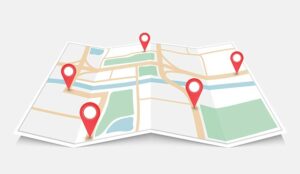Tamsin Dollin at NICE CXone shares customer journey mapping advice for today’s digital-first CX.
Thanks to global positioning systems (GPS), we mastered mapping journeys. They tell you where you are in unfamiliar places, get you from one place to another, can monitor personal movement, and more. That’s like this customer journey map template we’re giving you.
Combined with expert advice from our industry experts in this post, completing this template is like using a GPS device—it helps you identify every touchpoint in a customer’s journey from start to finish, and leads to a destination: great CX no matter what channels customers use.
Diagraming these different paths customers take might include what digital channels are involved, what technology they use to get there, or where they escalate to live agents (if they do need agent assistance).
It can help you identify upsell or cross-sell opportunities or what kind of support customers need to get first contact resolution.
According to Robin Gareiss, CEO and Principal Research Analyst at Metrigy, almost 35% of companies are doing customer journey mapping and over 30% have plans to do it in 2021. Why? Mapping journeys bolsters CX.
Link Between Journey Mapping and Customer Satisfaction
You want the end result of any journey to be satisfied customers, but getting there isn’t always a straightforward process. Where were those unplanned “surprise and delight” moments that led to customer satisfaction?
The stakes are high: you can win or lose even long-term customers based on their experiences at any step in the journey. Mapping multiple touchpoints in journeys impacts CX because you have to know where friction is in the process to fix it.
Digital Adoption Impact on the Customer Journey
According to Ventana Research, in today’s digital world, consumers communicate differently with each other, and this shift is having a direct impact on the way they engage with organizations. The mobile phone has become ubiquitous, enabling people to communicate whenever they choose.
The use of text messaging is replacing the spoken word, and the use of social media has skyrocketed. Customers can start journeys from Google search, apps, website, chat, and other places now. This is digital-first reality.
You build connections with customers who might choose digital channels like chat over traditional voice. They’ve already interacted on various digital channels, including your website, mobile apps, review websites, 3rd party communities, and virtual assistants.
Accenture reports that 66% use a search engine like Google to find solutions to issues, so how many of your customers start their journeys from a Google search and land on your website before interacting with a chatbot?
It’s a likely scenario: according to Accenture, 73% of Customers Prefer to Visit a Company Website Before Contacting Customer Service and 90% of People Worldwide Will Have Interacted With AI- and Machine Learning-driven Customer Support Bots Without Knowing It.
Customers might prefer resolving problems on their own through self-service, never speaking to your agent. In fact, Forrester Research predicts that digital customer service interactions will increase by 40% in 2021.
Delivering exceptional customer experiences (CX) in a digital-driven world where you might interact with customers regularly without ever talking to them is not a temporary trend.
Customer Preference for Self-Service
This customer preference for digital interaction motivates contact centre leaders to evaluate how their current self-service options perform, and there’s room for improvement.
In our benchmark study, we found that businesses believe that chatbots and virtual assistants need to get smarter before consumers are willing to use them regularly. Investing in your self-service technology is a real opportunity to elevate CX, because your customers truly embraced the “do-it-yourself” concept years ago.
Nuance Enterprise found that 67% of respondents to a 2020 survey said that they preferred self-service over speaking to a company representative.
Even before 2020, Forrester Research said self-service should be delivered when the customer is engaged, with a full understanding of their context, and in the flow of their actions within the application they are using.
Customers Don’t Want to Reintroduce Their Problem
And if they do transfer to an agent, that transition better be seamless and include historical customer information.
According to Kate Leggett, VP Principal Analyst in the 2019 Forrester Research article, agents should have full visibility of the customer journey so that they don’t have to repeat any of the information that has already been communicated.
How many times does a customer expect to repeat themselves even if that interaction starts in a digital channel? Zero. That’s right. Even if they’re using more than one channel or a mix of digital and voice channels, customers “expect no repeats, one answer, and multiple channels.”
Transforming a customer’s omnichannel experience into a single interaction without repetition differentiates your service from competitors.
This aligns with our research findings, too: Both businesses and consumers agree, 94% and 93% respectively, that companies should provide a seamless experience for customers when moving from one communication channel to another, such as chat to phone, to resolve their situation.
No matter where a customer journey starts, in this digital-first reality, it’s vital that transfers across channels are smooth.
What’s Better: Good Customer Service or Fast Customer Service?
Digital preferences might drive customer expectations of speedy resolution, but speed is still less important than friendly, competent service, as Gallup consultants discovered in a study conducted for a banking client.
Speed was a factor, but customers who gave the bank high ratings on a teller’s courtesy or willingness to help (“people” attributes) were nine times more likely to be fully engaged.
So prioritize customer satisfaction at every touchpoint in your customer’s journey and track metrics on service scores over average handling time to keep the focus on delivering great CX.
How Do Negative Social Media Reviews Impact Your Business?
In social media terms, how much your service falls short of expectations at any step of a customer’s journey is conversely related to how much they blast your business when complaining about your service on their social media channels.
Fair assessment or not, your other customers read about a negative experience, which might persuade them to give a competitor their business.
In a customer’s eyes, a frustrating interaction with your chatbot or a bad agent experience is grounds for an Instagram story, Facebook post, or other social channels. Social engagement has a real business impact.
Don’t you want to identify pain in customer touchpoints before reading about it on Facebook? Mapping captures customer data that helps you anticipate issues rather than react to them. Focusing on CX at every step in a customer’s journey isn’t about avoiding unpleasant reviews—it’s the key to retaining customers long-term.
If you’re ready to start mapping, then keep reading to learn more about journey mapping fundamentals, like:
- How to start customer journey mapping
- Using empathy mapping to map actual and ideal customer journeys
- Why mapping your agent’s journey is also important for CX
Let’s start digging in…
How to Start Customer Journey Mapping
A customer journey map, or a user or buyer journey map, is a visual representation of a customer’s multiple interactions with a brand, but it’s not limited to actual customer journeys. You can map ideal customer journeys and agent journeys, too, and really gain insight on how to improve CX.
Think of a customer or agent journey as a road trip including stops for snacks, bio breaks, and fuel. What happens at these stops can make the trip a pleasurable distraction from daily life or right up there with getting your eyebrows waxed.
These “stops” are a set of digital, voice, or combinations of channels or technology that form a customer or agent interaction in your contact centre.
One way to get started is to navigate the process as if you are the customer or agent. That way, you can start documenting the interaction points your customer has and see firsthand where there’s friction.
You’ll gain a lot of insight if you diagram the path you take with a specific goal in mind, like taking a journey that involves getting delivery information on an order online that transfers to an agent.
Your map would contain the channels and technologies you used in this journey, points of escalation, and any type of support that you needed to access to achieve resolution.
Mapping your own customer journey helps you identify pain points and prioritize what changes to make to smooth out the process. When you map the journey for all your customer segments, you’ll have actionable insight you can use to:
- Reduce friction in all customer journeys
- Train agents for common interactions they’ll encounter
- Identify what technology should be upgraded
- Improve CX at every touchpoint in digital and voice channels
- Optimize operations, making changes in a priority order based on data you collected
Some fixes that could have a real impact on CX might be fast and easy to implement, like simplifying self-service steps or changing on-hold music.
How to Map the True Customer Journey
If you have different customer segments, then you might want to map out the most common journeys your contact centre handles, where customers:
- Seek information
- Get technical support
- Buy a product
- Make a payment
- Schedule deliveries or other interaction
Customer perception of your business or brand is based on any one of these interactions. For instance, a bad chatbot experience might not be salvaged by a fantastic agent interaction—or a frustrated customer might exit the chat and check out a competitor’s website instead.
Every single interaction counts toward connecting with customers or disappointing them. It’s important to map out what customers are doing, feeling, and saying at each step so you can identify and fix the moments of friction encountered on their journeys.
How to Use Empathy Mapping to Find Opportunities for CX Improvement
One way to help measure if you’re getting each moment on the journey right and better understand your customers, is to fulfill an empathy mapping exercise as part of your customer journey mapping process. This is an aspect everyone in your organization should help fulfill—including your agents.
At each interaction a customer has with a business and your employees across all channels (whether it’s an agent-assisted channel or self-service), you’ll note what a customer thinks, says, does, and feels. You should practice this for each of your customer personas.
What Metrics Should Journey Mapping Include?
Although first-person quantitative metrics like customer sentiment, customer satisfaction metrics, NPS, etc. are going to give you the best results, agents can also provide front-line insight that might not be captured if you aren’t using a unified true omnichannel platform that captures integrated customer metrics across any channel.
The metrics you include should all be related to understanding what the customer is trying to do, feel, think, as you try to pinpoint moments of both friction and delight.
For digitally preferential customers, there are a few newer metrics to better understand and integrate customer preferences into your journey:
- Customer Empathy Metrics – For instance, sentiment analysis metrics for written and voice interactions.
- Customer Feedback Metrics – For instance, Customer Effort Score (CES) for self-service options or Customer Satisfaction Score (CSAT) for post-support chat scenarios.
- Operational Metrics – For instance, the number of chat interactions that led to issue resolution, or from where service requests originate. Another example is using customer’s web search queries compared with resolution scores to help understand opportunities for improvement.
It’s important to keep in mind that the customer’s journey begins long before the customer initiates outreach with an agent, that the physical channels matter as much as the digital channels, and that each customer might have a different path of support.
How to Map the Ideal Customer Journey
It might also be helpful to do fulfill an empathy mapping exercise where you chart the ideal state v. the actual state. What’s your customer’s ideal journey? It depends on the kind of interactions you manage.
A customer with a complex problem, like receiving the wrong outdoor furniture then being double charged for the purchase, might care more about agent support knowledge and quality of service.
Someone needing to recover a password could be more interested in self-service options and fast resolution. Agents might need an improved knowledge base to answer the most common customer questions or sales training to confidently upsell or cross-sell products.
Identify the experience you want customers and agents to have, then remove friction in those processes. By addressing those pain points in the journeys, you’ll deliver that ideal experience that exceeds customer expectations.
Journey Map and Measure Your Employee Experience (EX), aka Agent Experience (AX)
Leverage what you learned from mapping a customer journey and diagram the agent’s journey, too. You’ll see where agents need more support. Do they need empathy training to equip them for complex problems in chat interactions?
Are customer transfers from self-service to agent smooth? Are there weaknesses in the technology they use daily like the knowledge base? These are questions agent journey mapping can help you answer when you diagram it from an agent’s perspective.
You’ll identify friction in their process, and show you’re invested in improving AX, too.
Agent experience goes together with delivering great CX. According to Gartner, “nearly six in 10 (57%) of customer-facing employees say they do not feel ‘set up to succeed’ in their customer interactions. This should be alarming to every executive.”
In the study, Gartner concluded there was a straight line between “how your employees feel about the way they’re being managed” and “how your customers feel about wanting to continue doing business with you.”
Agents used to be a primary customer support option, but this shift in customer preferences to using digital channels expanded their roles. Agent journeys now include:
- Sales
- Upselling
- Customer service
- Technical support
- Recommendations
- Combinations of customer service, sales, or technical support and more
Instead of reacting to customer contacts, agents can anticipate needs or speed up the resolution with the right smart, AI-powered tools, like better self-service, a formalized knowledge program, or real-time guidance. But upgrading technology only solves half of the problem.
Agents need specific training that prepares them for establishing rapport in a digital channel, overcoming objections in a sales call, or preventing escalation to managers when a frustrated customer transfers from chat.
Through agent journey mapping, you understand how agents find answers to customer questions, where they struggle to complete interactions quickly, if they need refreshers on technical training, or what kind of training they need.
This blog post has been re-published by kind permission of NICE CXone – View the Original Article
For more information about NICE CXone - visit the NICE CXone Website
Call Centre Helper is not responsible for the content of these guest blog posts. The opinions expressed in this article are those of the author, and do not necessarily reflect those of Call Centre Helper.
Author: NICE CXone
Published On: 9th Aug 2021 - Last modified: 25th Apr 2024
Read more about - Guest Blogs, NICE CXone, Tamsin Dollin






 NICE CXone combines best-in-class Omnichannel Routing, Workforce Engagement, Analytics, Automation and Artificial Intelligence on an Open Cloud Foundation.
NICE CXone combines best-in-class Omnichannel Routing, Workforce Engagement, Analytics, Automation and Artificial Intelligence on an Open Cloud Foundation. 






























